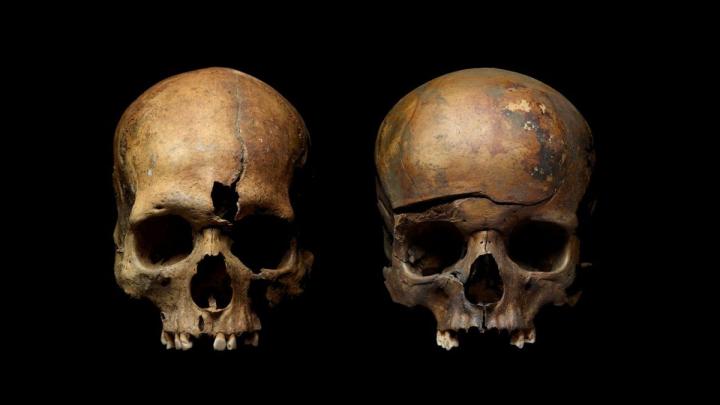a few more years and they could have died of plague –
DNA says several people buried in a mass grave after the 1278 attack were related.

Institute of Archeology, Russian Academy of Sciences
Archaeologists excavated part of the old city center of Yaroslavl, Russia, between 2005 and 2010 as part of an effort to restore its cathedral. During the digs, they discovered nine medieval mass graves holding the remains of at least 300 people, dating from the sack of the city by Mongols. It took another several years for their bones, the ancient DNA preserved within them, and some centuries-old blowfly larvae, to reveal a family tragedy set against the wider backdrop of Mongol expansion.
Fire and bodies lying in the snow
In the first half of the 1200 s, Mongol leader Batu Khan (the grandson of Genghis Khan) conquered parts of modern-day Russia, Eastern Europe, and the Caucasus, adding them to what became known as the Golden Horde. He swept westward with an army of 130, 000 soldiers, and for the cities in his path, the only options were surrender or slaughter. Smolensk opted to surrender and pay tribute to the Khanate, but 18 other cities — including Moscow and the capital of the principality that, at the time, ruled Yaroslavl — fell to fire and the sword.
The Mongol army reached Yaroslavl in February 1238. Many of the people buried in the mass graves afterward had clearly died violently; their bones carried the marks of stabbing, cutting, and blunt trauma. Some of the bones also showed signs of having been burned, probably in the fire that accompanied the attack, according to historical documents and archaeological evidence. Several of the graves had been the basements of houses and outbuildings; after the buildings burned down in the fire, the survivors or the conquerors found the exposed basements convenient places to dispose of the dead.
On the grounds of a medieval estate in the center of town, near the cathedral, someone went to the trouble to dig a pit for the dead. But the fifteen people buried in the shallow pit lay in a variety of poses, suggesting that they had been dumped in unceremoniously. The blowfly larvae found mingled with the bones might explain that hasty treatment: the bodies would have been in the smelliest stages of decomposition when burial finally happened.
The larvae remained in remarkably good condition, even after 800 years of burial. Entomologists identified the exact blowfly species — and calculated that around Yaroslavl, the average daily temperatures the larvae would need came in late May or early June.
“These people were killed, and their bodies remained lying in the snow for a fairly long time. In April or May, flies started to multiply on the remains, and in late May or early June, they were buried in a pit on the homestead, which is where they probably had lived, ”said archaeologist Asya Engovatova of the Russian Academy of Sciences . By then, Batu Khan and his army were already marching through Crimea.
A family tragedy worthy of Dostoyevsky
Several of the people buried in the pit had much more tooth decay than the rest of the Yaroslavl dead, which actually suggests that they were pretty well-off. Tooth decay usually suggests a diet rich in sugar (or at least soft, high-carbohydrate foods). In the Middle Ages, only the wealthy would have had access to that much sugar. And artifacts found where the house once stood suggest that the estate had been relatively wealthy until it burned down during the Mongol attack. Engovatova says it’s reasonable to think that the people buried in the middle of the estate lived — and died — there.
Some clues in the bones suggested that a number of the people in the mass grave may have been related. Several of the skeletons shared traits that could have been hereditary, such as spina bifida and a cranial suture (one of the joints between bones in the skull) that stayed open long after the age when it usually fuses shut.
To test that idea, geneticists Kharis Mustafin and Irina Alborova of the Moscow Institute of Physics and Technology sampled ancient DNA material from eight skeletons. Three of them shared the same mitochondrial genome, which is passed down from mother to child. Anthropologists say the three relatives were a woman, probably at least 55 years old when she died; a woman somewhere between 30 and 40 years old; and a young man about 20 years old.
The DNA analysis also helped calculate how closely the people were related; Engovatova and her colleagues say the most likely scenario is that the three people represent a grandmother, her daughter, and her grandson. Another person, buried in a nearby grave, came from the same maternal lineage. Engovatova and her colleagues presented their findings at a recent international anthropology conference in Moscow.
“In addition to recreating the overall picture of the fall of the city in 1238, we now see the tragedy of one family, ”said Engovatova. “What’s not known, of course, is who buried them: a relative, a neighbor, or a conqueror?”
Yaroslavl rebuilt after the fire as it had done after numerous other fires in its history; it was a city made mostly of wood in a time when people relied on fire for cooking and heating. The principality to which the town belonged would spend the next 250 years as a vassal state to the Golden Horde but not without more conflict and death. Batu Khan’s cousin, Mongke Khan, swept through the region again in 1257, followed by the Black Death in 1278, more Mongol attacks in 1293 and 1322 , and another wave of Black Death in 1364.







GIPHY App Key not set. Please check settings